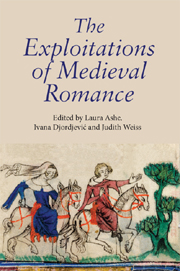Book contents
- Frontmatter
- Contents
- Preface
- Notes on Contributors
- Abbreviations and Editorial Note
- Introduction
- 1 The Fairies in the Fountain: Promiscuous Liaisons
- 2 Saracens and Other Saxons: Using, Misusing, and Confusing Names in Gui de Warewic and Guy of Warwick
- 3 The Exploitation of Ideas of Pilgrimage and Sainthood in Gui de Warewic
- 4 Chanson de geste as Romance in England
- 5 Patterns of Availability and Demand in Middle English Translations de romanz
- 6 Reading a Christian–Saracen Debate in Fifteenth-Century Middle English Charlemagne Romance: The Case of Turpines Story
- 7 Subtle Crafts: Magic and Exploitation in Medieval English Romance
- 8 Meeting Grounds: Gardens in Middle English Romance
- 9 ‘Als for the worthynes of þe romance’: Exploitation of Genre in the Buik of Kyng Alexander the Conquerour
- 10 Sir Gawain and the Green Knight and the Limits of Chivalry
- Index of Manuscripts
- General Index
8 - Meeting Grounds: Gardens in Middle English Romance
Published online by Cambridge University Press: 12 September 2012
- Frontmatter
- Contents
- Preface
- Notes on Contributors
- Abbreviations and Editorial Note
- Introduction
- 1 The Fairies in the Fountain: Promiscuous Liaisons
- 2 Saracens and Other Saxons: Using, Misusing, and Confusing Names in Gui de Warewic and Guy of Warwick
- 3 The Exploitation of Ideas of Pilgrimage and Sainthood in Gui de Warewic
- 4 Chanson de geste as Romance in England
- 5 Patterns of Availability and Demand in Middle English Translations de romanz
- 6 Reading a Christian–Saracen Debate in Fifteenth-Century Middle English Charlemagne Romance: The Case of Turpines Story
- 7 Subtle Crafts: Magic and Exploitation in Medieval English Romance
- 8 Meeting Grounds: Gardens in Middle English Romance
- 9 ‘Als for the worthynes of þe romance’: Exploitation of Genre in the Buik of Kyng Alexander the Conquerour
- 10 Sir Gawain and the Green Knight and the Limits of Chivalry
- Index of Manuscripts
- General Index
Summary
The topic of gardens in medieval romance is surely well-tilled ground, at once significant and banal. In all the calendars and engagement books that well-meaning friends and relations give us we see how seductive are those familiar pictures of richly colored flowers and spouting fountains, where the pleasures of artful nature are enjoyed and noble lovers meet. E. R. Curtius, Elizabeth Salter and Derek Pearsall, along with many others, have demonstrated the long literary history and rich symbolic content of the hortus conclusus, or locus amoenus, a space which in the Middle Ages was known from classical poetry and Biblical commentary even before it came to be actually imitated in later periods of increasing affluence and social display. Thanks to scholars and critics we have learned that a garden is never simply a space devoted to ornamental plants, but one suffused with meanings, sometimes overlapping, sometimes conflicting, but seemingly always available, most famously in that foundational text for medieval vernacular poetry, the Roman de la Rose. As Michael Pollan puts it, even biology itself is apparently complicit in this process of troping nature, making of the green world a readable code:
This stands for that: flowers by their very nature traffic in a kind of metaphor, so that even a meadow of wildflowers brims with meanings not of our making. Move into the garden, however, and the meanings only multiply as the flowers take aim not only at the bee's or the bat's or the butterfly's notions of the good or the beautiful, but at ours as well.
- Type
- Chapter
- Information
- The Exploitations of Medieval Romance , pp. 125 - 138Publisher: Boydell & BrewerPrint publication year: 2010



